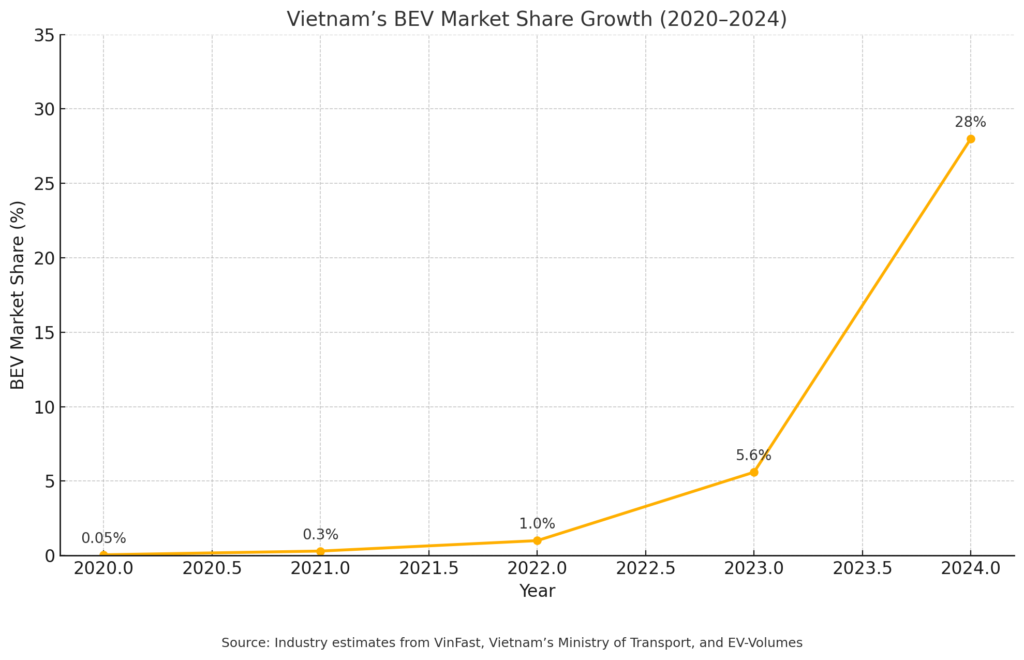Vietnam may not be the first country that comes to mind when talking about electric vehicle (EV) adoption, but it’s time that changed. In the span of just four years, Vietnam has gone from virtually zero electric cars on the road to one of the most dynamic and unexpected EV success stories globally — beating every other country in year-over-year growth.
Going from 0.05% to 28% market share in just 4 years represents a 55,900% increase — a 560x jump in EV adoption. That’s an astronomical growth rate, and according to industry estimates from VinFast and Vietnam’s Ministry of Transport, supported by tracking from EV-Volumes and regional market observers, there’s no other country that comes remotely close to that level of percentage increase in EV adoption.
And to be clear: this isn’t just rapid growth — it’s record-breaking. When it comes to battery electric vehicle (BEV) adoption, no other nation tracked has gone from near-zero to mainstream adoption faster than Vietnam. Most developed countries took a decade or more to shift from 1% to 20% BEV penetration. Vietnam did it in just two years.
From 2020 to 2025, Vietnam’s EV rise is unmatched in its velocity.
A Four-Year Disruption
Let’s break it down:
| Year | BEV Sales | YoY Growth | BEV Market Share |
|---|---|---|---|
| 2020 | Negligible | — | <0.1% |
| 2021 | <1,000 | — | ~0.3% |
| 2022 | ~4,000 | ~300% | ~1.0% |
| 2023 | 15,700 | +292% | 5.6% |
| 2024 | 87,000–97,000* | +450–500% | 25.6–28.5% |
Here’s the surge in action:

That’s transformation on a timeline few thought possible.
VinFast Leads the Charge
Homegrown automaker VinFast is at the heart of this electric revolution. In 2024, it delivered up to 97,000 EVs globally, with 87,000–90,000 sold in Vietnam. That means over 25% of all new cars sold in the country were battery electric — with VinFast almost singlehandedly carrying the torch.
VinFast isn’t just moving quickly — it’s thinking long-term:
- Its vehicles are powered by **LFP (lithium iron phosphate) batteries, known for safety, long cycle life, and lower cost compared to nickel-based alternatives.
- It sources battery packs from global leader CATL.
- It’s also investing in solid-state battery research, via strategic partnerships aimed at next-generation breakthroughs.
While VinFast’s dominance is a major strength, Vietnam’s EV future will depend on how well the company scales sustainably amid supply chain hurdles and rising global competition.
Outpacing the World
To give some perspective:
Other Hot Growth Markets: Brazil and Uruguay are also making headlines. Brazil more than doubled its NEV share in 2024, and Uruguay hit 15% BEV market share by mid-2024 — both thanks to bold policy shifts and strong Chinese OEM presence. Still, Vietnam’s pace remains in a league of its own.
- China: The world’s biggest EV market grew ~20–30% YoY in 2024.
- USA: Managed ~7–10% growth.
- Europe: Stalled amid subsidy cuts and market saturation, with major markets like Germany even seeing BEV sales decline.
- Thailand: Saw steady growth (~12–15% BEV share) with foreign OEMs like BYD and Neta leading, while Vietnam’s homegrown VinFast drove a sharper surge.
Vietnam? From 5.6% to nearly 30% BEV share in one year.
That’s a growth curve most markets can only dream of.
A Personal Benchmark
To really grasp how staggering Vietnam’s BEV growth is, I need to reflect on where I live — Australia. In 2024, we sold over 1.2 million new cars, yet only 91,292 were BEVs — a modest 7.4% market share.
Vietnam, by contrast, is operating on a completely different curve. Despite selling fewer total vehicles — with an estimated 400,000–420,000 passenger cars in 2024 — it moved nearly 100,000 battery electric cars, almost entirely from VinFast. That puts its BEV market share somewhere between 25% and 28%, depending on the final sales numbers.
Let that sink in: a developing country with a smaller car market and far lower income per capita has triple the EV adoption rate of Australia. It’s not just impressive — it’s paradigm-breaking.
Vietnam shows us that disruption doesn’t follow GDP rankings. It follows alignment — of policy, product, and public momentum. What we’re witnessing is S-curve disruption , and it’s happening where few expected.
What’s Driving It?
Backed by Policy: The Road to Low-Emission Zones
Vietnam’s EV surge isn’t just about demand — it’s being hardwired into policy. Hanoi, the capital, is set to launch low-emission zones (LEZs) in 2025, starting with districts like Hoan Kiem and Ba Dinh, where only non-polluting and clean-energy vehicles will be allowed. Gasoline and diesel cars? Banned from select areas on weekends and eventually phased out entirely in some zones.
This isn’t a future plan buried in bureaucracy — it’s rolling out now. The Vietnamese government is signaling loud and clear: the internal combustion engine’s days are numbered.
These moves add serious structural weight to what’s already a grassroots shift. It’s not just consumers buying VinFast EVs — it’s the state creating conditions where ICE vehicles will soon feel outdated, inconvenient, or outright restricted.

Challenges Ahead
While Vietnam’s EV story is remarkable, it’s not without hurdles:
- Infrastructure Load: Can Vietnam’s energy grid support mass electrification?
- VinFast Dependence: A single-player market raises sustainability questions.
- Global Pressure: As EV competition heats up globally, scaling production efficiently and maintaining quality will be key.
- Subsidy Shifts: Changes in government support could affect affordability.
- Affordability: Models like the VinFast VF 3, priced under $20,000, unlocked the mass market.
- National Pride & Identity: VinFast isn’t just a car brand — it’s a source of national pride. “Made in Vietnam” campaigns have stirred patriotic enthusiasm, with buyers queuing to support their homegrown champion.
- Policy-Driven Transformation: The Vietnamese government has backed EVs with tax breaks, ICE restrictions, and environmental regulations. In 2024, they launched ICE-free zones in cities like Hanoi, enforced pollution penalties up to 1.2 million VND per violation, per a 2024 decree, and doubled down on a green transport roadmap.
- Infrastructure Push: Charging networks are expanding rapidly thanks to both state and private investment.
- Strategic Clarity: Vietnam has set its sights on net-zero by 2050 — and EVs are a cornerstone of the plan.
Why the World Should Pay Attention
Vietnam’s rapid success could serve as a playbook for other developing nations:
- Thailand and Indonesia, both with ambitions to be EV manufacturing hubs, now face pressure to match Vietnam’s pace.
- Vietnam’s blend of policy, affordability, and nationalism offers a template for leapfrogging legacy infrastructure.
Vietnam’s EV surge is a reminder that technology adoption doesn’t follow a single path. It’s not just about income levels or legacy brands. Sometimes, all it takes is:
- A bold local disruptor,
- Smart government policy,
- And a population ready to leap into the future.
Final Thoughts
Vietnam is no longer a footnote in the EV story — it’s a headline.
While the world watches Tesla, BYD, and legacy OEMs battle for dominance, a far more radical transformation is quietly rewriting the rules in Southeast Asia. Vietnam’s surge from 0.05% to 28% BEV market share in just four years isn’t just unprecedented — it’s S-curve disruption on steroids. No other nation has accelerated this fast, from such a low base, in so little time.
This isn’t just about EVs. It’s about what happens when policy, timing, national pride, and a bold local player collide with market readiness. VinFast may have lit the fuse, but what we’re seeing now is a broader systemic shift — one that challenges the assumption that only wealthy or mature markets can lead the clean transport transition.
The road ahead is electric — but keeping this momentum will depend on infrastructure scale-up, healthy competition, and VinFast’s ability to move from national champion to global contender. If those pieces fall into place, Vietnam won’t just be leading growth — it’ll be redefining how disruption happens. Because this? This isn’t evolution. It’s acceleration.⚡🇻🇳
Got thoughts or want to share insights? Reach out or drop a comment — the EV revolution isn’t waiting, and neither should you. Could Vietnam’s surge become the blueprint for emerging markets around the world?

